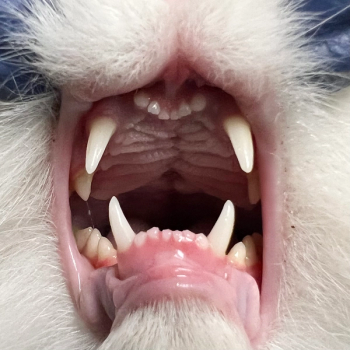
DVM's research results in first patent for canine elbow replacement at ISU
Ames, Iowa-Iowa State University (ISU) lays claim to a first for veterinary medicine.
Ames, Iowa-Iowa State University (ISU) lays claim to a first for veterinary medicine.
Before the total elbow replacement's prosthetic device was tried on a canine patient recipient, the Iowa State University (ISU) surgical team had already come up with 15 modifications. Dr. Michael Conzemius, an associate professor of veterinary clinical sciences at ISU, is credited with the design of the new prosthetic and surgical technique for total elbow replacement.
The claim is for a newly patented total-elbow replacement joint for dogs that was designed by a veterinary surgeon at ISU.
Dr. Michael Conzemius, an associate professor of veterinary clinical sciences at ISU's College of Veterinary Medicine, tells DVM Newsmagazine that the procedure and prosthetic design are the culmination of about five years worth of work and numerous design modifications.
To date, the technique has been used on 20 dogs. Conzemius used computerized gait analyses and monitored the recovery for one year. The result: about 80 percent had good or excellent outcomes following total elbow replacement surgery.
Need is out there
He adds there is a need for total elbow surgeries to correct severe arthritis. Estimates are 1,000 dogs per year will be ideal candidates for the surgery when it becomes widely available in the United States. But that has a long way to go since the technique is relatively new, and total elbow replacements are only being performed at ISU.
Conzemius says that the canine elbow poses problems for geriatric animals in that it functions like the human knee absorbing the stress of walking, climbing and running. Therefore, canine elbow problems are a common medical condition, especially for older animals suffering from arthritis.
"As far as the frequency of the disease, 8 percent of cases that present to university hospitals for limping present because of arthritis in the elbow. So, it is a pretty common problem, but it would be performed on a limited basis because of the financial investment required of owners," he says.
Currently, Conzemius estimates surgery costs for owners at about $3,000-$5,000. Conzemius expects the total-elbow replacement joint will be licensed in the next year for commercial manufacture. The Iowa State University Research Foundation holds the patent.
Dr. Michael Conzemius, an associate professor of clinical sciences at Iowa State University, says that canine elbow problems are out there. Estimates are that 8 percent of cases that present to university hospitals for limping are due to arthritis in the elbow.
The research and development of the total-elbow replacement joint was funded by the American College of Veterinary Surgeons and ISU's College of Veterinary Medicine and Center for Applied Technology Development.
Helping dogs
Conzemius says dogs that are ideal candidates for the surgery have a very limited range of motion.
"We go into the joint and cut and release a lot of the scar tissue and break that down in the surgical procedure. We remove arthritic bone that is on the humerus, ulna and head of the radius. Two implants are placed." Conzemius adds there is a humeral prosthetic which is made out of stainless steel or cobalt chromium and a radial ulnar component which is made out of a medical grade polymer.
The two prosthetics were designed in four sizes to accommodate different breeds. Conzemius' surgical team refined the design 15 times before performing the surgery on a patient.
"We spent a great deal of time studying the mechanics and the anatomy of the elbow and the variations we'd need for different breeds. We also studied all parts of the bones that make the joint, because most joint replacements have stems that go up into the bones," he explains.
He adds, "The elbow is a complex joint. It's a three-bone system and everything has to meet up perfectly or the dog ends up with instability, pain or uneven wear of the cartilage in the joint."
The designs have not yet been picked up by a company for license to manufacture, but that is the next step in the process.
The message: Don't look for elbow replacement surgery to sweep the country as the newest offering in orthopedics. Although it might become commonplace, it will take time.
Conzemius hopes there will be a number of different institutions offering the surgery in the next year or so.
From a general practitioner's perspective, it is a tough surgery that requires a couple of hours to perform, he explains. Training for board surgeons interested in learning this procedure is currently being discussed by the university.
A question of pride?
So, how much of a thrill was it to get a patent on a unique design? For Conzemius personally, it is just another day at the office and one more step in attempting to help dogs.
"It wasn't a big deal for me. For it to benefit a lot of dogs, there needs to be a commercial process. And that's what this is all about. Some company is going to have to say, 'wow, we want this license,' " he adds.
"I really enjoy doing the design and finding out what works and what doesn't work. We are still in that process. The implant technique will get better, and we are at a stage now where we need other surgeons to do this and provide advice with what they need or the subtle changes that might be beneficial so we can continue to improve the surgeries and how we place the implants," he explains.
Newsletter
From exam room tips to practice management insights, get trusted veterinary news delivered straight to your inbox—subscribe to dvm360.






